CDROM motors
Click on any photo for a full size image.
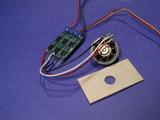 I'm starting to experiment with brushless motors for small helicopters
and airplanes. The photo shows a CDROM motor after being removed from
a 12X drive and rewound with 19 turns of 28ga wire on each of 9
poles. The controller is a Castle Creations Phoenix 10 sensorless
controller. The entire package, including the plywood, weighs 28
grams (1oz). In contrast, an Orion Elite Modified motor weighs 42
grams without a controller.
I'm starting to experiment with brushless motors for small helicopters
and airplanes. The photo shows a CDROM motor after being removed from
a 12X drive and rewound with 19 turns of 28ga wire on each of 9
poles. The controller is a Castle Creations Phoenix 10 sensorless
controller. The entire package, including the plywood, weighs 28
grams (1oz). In contrast, an Orion Elite Modified motor weighs 42
grams without a controller.
This motor is od nice quality, with two ball bearings holding the
shaft at each end of the stator (the part with the windings). The
outer bell holds the magnets and rotates around the stator. The stator
must be mounted on something and the motor shaft connected do a
direct-drive prop or gearing system.
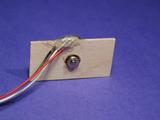 In the CDROM, the stator was press-fit and swaged into a piece of
metal. I considered leaving it attached to the metal, but it would
have been harder to rewind the motor and much heavier when
completed. Epoxying the stator to a piece of 1/16-inch airplane
plywood seemed like a good compromise.
In the CDROM, the stator was press-fit and swaged into a piece of
metal. I considered leaving it attached to the metal, but it would
have been harder to rewind the motor and much heavier when
completed. Epoxying the stator to a piece of 1/16-inch airplane
plywood seemed like a good compromise.
Mounting in an airplane is simple - just drill some holes in the
plywood and fasten to the firewall. It could also be glued, but would
then be more difficult to remove in the case of maintenance.
|
Mounting in my Piccolo helicopter may be a challenge. In one case,
the plywood motor mount could be above the motor, so I'd need spacers
to mount it to the Piccolo frame. In the other case, the brass
retainer that is press-fit onto the motor shaft (see the photo to the
right) on the stator side could be replaced with a pinion gear.
That's what the fellow in Germany has done with his
motors. Using his example, I determined that the motor shaft is
press-fit into the rotor. I was able to press it through the rotor
housing extending the shaft below the plywood on which I mounted
the stator (the part with the windings in this motor). Doing this
allowed me to easily mount it on the Piccolo, being careful to route
the wires around the motor since the motor housing rotates. The motor
shaft is 3mm (.0118in). At the advice of Paul Goelz, I used an Astro 010
10-tooth pinion (.0125in), which fits with no noticable wobble.
|
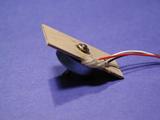
|
|
I've pressed the motor shaft through the magnet housing and there is
now plenty of motor shaft to allow for the thickness of the mounting and for attaching the pinion gear.
|
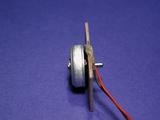
I'm also researching pinions to fit the shaft, which is 3mm (.0118in).
Most pinions are either 2mm or 1/8 in (3.2mm). Paul Golez reports
that the Astro 010 pinion (1/8-inch) works nicely. I'll give that a
try, possibly shimming with a piece of tissue to give a snug fit.
|
I've also scored the shaft slightly parallel to its center line in
order to give it more friction. A better approach might be to cut two
or three lines in the shaft with a scribe. The flare on the edges of
the scribed line will help hold a pinion or press-on prop as shown.
|
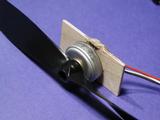
|
Back to the home page
Copyright, 2002, Terry Slattery, All rights reserved.
 I'm starting to experiment with brushless motors for small helicopters
and airplanes. The photo shows a CDROM motor after being removed from
a 12X drive and rewound with 19 turns of 28ga wire on each of 9
poles. The controller is a Castle Creations Phoenix 10 sensorless
controller. The entire package, including the plywood, weighs 28
grams (1oz). In contrast, an Orion Elite Modified motor weighs 42
grams without a controller.
I'm starting to experiment with brushless motors for small helicopters
and airplanes. The photo shows a CDROM motor after being removed from
a 12X drive and rewound with 19 turns of 28ga wire on each of 9
poles. The controller is a Castle Creations Phoenix 10 sensorless
controller. The entire package, including the plywood, weighs 28
grams (1oz). In contrast, an Orion Elite Modified motor weighs 42
grams without a controller.



